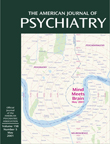Emily Dickinson Revisited: A Study of Periodicity in Her Work
Abstract
OBJECTIVE: Emily Dickinson, arguably one of America’s foremost poets, is characterized by critics as able to capture extreme emotional states in her greatest work. Recent dating of her poems offers the periodicity of her writing as a behavior that can be examined for patterns of affective illness that may relate to these states. METHOD: The bulk of Dickinson’s work was written during a clearly defined 8-year period when she was age 28–35. Poems written during that period, 1858–1865, were grouped by year and examined for annual and seasonal distribution. RESULTS: Her 8-year period of productivity was marked by two 4-year phases. The first shows a seasonal pattern characterized by greater creative output in spring and summer and a lesser output during the fall and winter. This pattern was interrupted by an emotional crisis that marked the beginning of the second phase, a 4-year sustained period of greatly heightened productivity and the emergence of a revolutionary poetic style. CONCLUSIONS: These data, supported by excerpts from letters to friends during this period of Dickinson’s life, demonstrate seasonal changes in mood during the first four years of major productivity, followed by a sustained elevation of creative energy, mood, and cognition during the second. They suggest, as supported by family history, a bipolar pattern previously described in creative artists.



